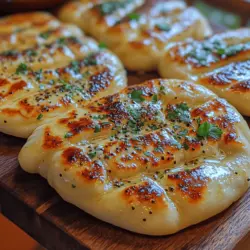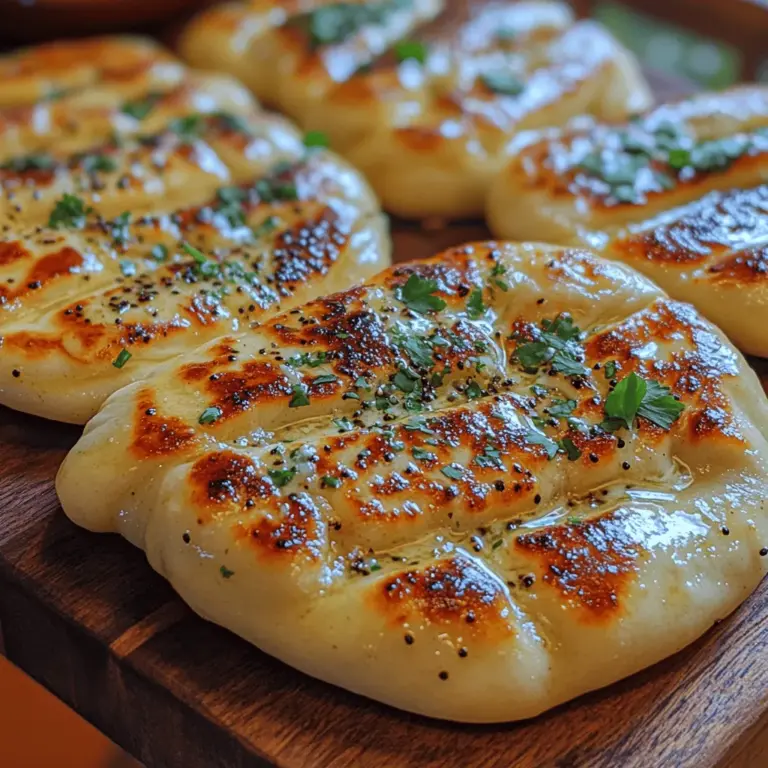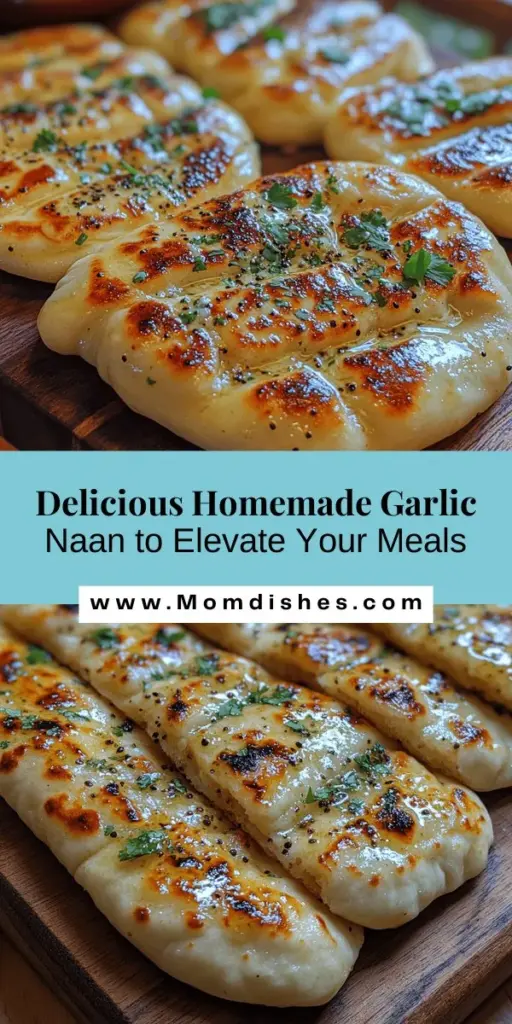Introduction to Heavenly Garlic Naan
Garlic naan is a beloved Indian flatbread that perfectly complements a variety of dishes, from rich curries to fragrant stews. Its origins can be traced back centuries, with naan itself believed to have been enjoyed since the time of the Mughal Empire. This delectable bread has not only found its roots in Indian cuisine but has also made its way onto the tables of food lovers worldwide, becoming a staple in many South Asian restaurants. The soft, pillowy texture and the aromatic flavor of garlic make garlic naan an irresistible choice for anyone looking to elevate their meal experience.
The allure of naan lies in its versatility; it can be served as a side dish, used to scoop up sauces, or even enjoyed on its own. Garlic naan, in particular, stands out with its unique flavor profile. Infused with the rich essence of garlic and often finished with a drizzle of butter, this bread offers a delightful contrast of flavors. Its golden-brown exterior, combined with a soft, chewy interior, creates a perfect balance that keeps diners coming back for more. Whether you are a seasoned chef or a novice in the kitchen, making garlic naan at home is an enjoyable and rewarding endeavor.
Understanding the Ingredients
Creating the perfect garlic naan starts with understanding the key ingredients that contribute to its wonderful flavor and texture. Each component plays a crucial role in the overall outcome of the bread, and knowing how they interact will set you up for success.
All-Purpose Flour: The Foundation of Naan
At the heart of any naan recipe is all-purpose flour, which acts as the foundation of the bread. This type of flour is commonly used in baking due to its balanced protein content, which typically ranges between 10% to 12%. The protein in flour is essential for gluten development, which gives bread its structure and chewiness. When making naan, you want to achieve a soft yet slightly elastic texture that can hold up when paired with hearty dishes.
Using all-purpose flour allows for a tender naan that can easily be torn and shared. While some recipes may call for bread flour, which has a higher protein content, all-purpose flour is sufficient for achieving great results. The key is to focus on the kneading process, which helps develop the gluten structure needed for the perfect naan.
Yeast: The Key to Leavening
Yeast is another vital ingredient in the naan-making process. Specifically, instant yeast is often favored due to its convenience and quicker activation compared to active dry yeast. Instant yeast can be mixed directly into the flour without needing to be dissolved in water first. It works by fermenting sugars in the dough, producing carbon dioxide gas that causes the dough to rise.
In most recipes, a small amount of sugar is added to activate the yeast. This sugar not only aids in fermentation but also contributes to the overall flavor of the naan. As the yeast grows, it creates a light and airy texture that is characteristic of well-made naan.
Salt and Sugar: Balancing Flavors
Salt is an essential ingredient that serves multiple purposes in naan dough. It enhances the overall flavor and helps control yeast fermentation, preventing it from becoming too active too quickly. A well-balanced amount of salt can elevate the taste of the naan, making it more enjoyable alongside savory dishes.
Sugar, while often seen as a sweetener, plays a crucial role in the dough as well. Beyond activating the yeast, sugar affects the browning of the naan during cooking. A touch of sugar can give the bread a beautiful golden hue, adding to its visual appeal.
Warm Water: The Perfect Temperature
Warm water is another critical component in the naan-making process. It is essential for activating the yeast and creating an environment conducive to fermentation. The ideal temperature for the water should be around 100°F to 110°F (37°C to 43°C). Water that is too hot can kill the yeast, while water that is too cold may not activate it effectively.
When combined with the other ingredients, warm water helps create a cohesive dough, allowing all the components to blend seamlessly. This is vital for achieving the right consistency—smooth and elastic yet not overly sticky.
Yogurt: Adding Richness
In many garlic naan recipes, yogurt is included to enrich the dough. The addition of yogurt not only contributes to the tenderness of the bread but also introduces a subtle tang that enhances the flavor profile. The acidity in yogurt helps to break down the proteins in the flour, resulting in a softer texture.
Moreover, yogurt can aid in the fermentation process, creating a more complex flavor in the finished naan. It’s an ingredient that not only helps with texture but also adds depth to the overall taste.
Butter and Garlic: Flavor Enhancers
No garlic naan would be complete without the bold flavors of garlic and the richness of butter. Traditionally, melted butter is brushed over the naan just after it comes off the grill or baking surface, creating a luscious coating that enhances both flavor and moisture.
Garlic, when added to the naan dough, infuses the bread with its distinctive aroma and taste. The combination of warm, melted butter and fresh garlic creates a tantalizing experience that pairs beautifully with a myriad of dishes, from spicy curries to fragrant rice.
Cilantro and Optional Seeds: Garnishing for Flavor
To finish off the garlic naan, fresh herbs and optional seeds are often used as garnishes. Chopped cilantro adds a burst of freshness and a pop of color, making the naan visually appealing. It also complements the garlic flavor, creating a harmonious blend of tastes.
Additionally, some recipes call for nigella or sesame seeds as optional toppings. These seeds not only add texture but also bring a nutty flavor that enhances the overall complexity of the naan. While garnishing is not strictly necessary, it can elevate the presentation and flavor of your garlic naan.
Step-by-Step Guide to Making Heavenly Garlic Naan
Now that we have a solid understanding of the ingredients, let’s dive into the step-by-step process of making heavenly garlic naan.
Preparation of Ingredients
The first step in your naan-making journey is to prepare your ingredients. Accurate measurements are crucial for achieving the perfect dough, so be sure to use a kitchen scale or measuring cups for precision. Gather all your ingredients, including all-purpose flour, instant yeast, sugar, salt, warm water, yogurt, garlic, and butter.
Additionally, prepare your workspace by cleaning the counter or table you’ll be using. Gather the necessary tools, such as mixing bowls, a whisk or wooden spoon for combining the ingredients, and a clean surface for kneading the dough. Having everything within reach will make the process smoother and more enjoyable.
Making the Dough
Once your ingredients are prepared, it’s time to make the dough. In a large mixing bowl, combine the all-purpose flour, instant yeast, sugar, and salt. Whisk these dry ingredients together to ensure even distribution.
Next, create a well in the center of the dry mixture and pour in the warm water and yogurt. Using a wooden spoon or your hands, begin to mix the ingredients until they start to come together. The goal is to form a shaggy dough that holds together but is not too sticky.
As you mix, you may find that the dough is too dry or too wet. If it feels too dry, add a little more warm water, one tablespoon at a time. Conversely, if it’s too sticky, sprinkle in a bit more flour until you achieve the desired consistency.
Kneading Techniques
Once the dough has formed, it’s time to knead it. Turn the dough out onto a lightly floured surface. Kneading is a crucial step that develops the gluten structure, resulting in a soft and chewy naan.
To knead the dough, push it down and away from you using the heel of your hand. Fold it over onto itself, give it a quarter turn, and repeat the process. Continue kneading for about 8-10 minutes, or until the dough becomes smooth and elastic.
You can also perform a windowpane test to check if the gluten has developed sufficiently. Take a small piece of dough and stretch it between your fingers. If it stretches without tearing and forms a thin, translucent membrane, it’s ready for the next step.
After kneading, shape the dough into a ball and place it in a lightly greased bowl, covering it with a damp cloth or plastic wrap. Allow the dough to rise in a warm place for about 1 to 2 hours, or until it has doubled in size. This fermentation period is essential for developing flavor and texture in your garlic naan.
With these initial steps, you are well on your way to creating your own heavenly garlic naan. The next part of this recipe will guide you through shaping the naan and cooking it to perfection, ensuring that you achieve that restaurant-quality experience right in your own kitchen. Stay tuned for the continuation of this delicious journey!
{{image_1}}
Importance of Kneading for Gluten Development
Kneading is a crucial step in making the perfect garlic naan, as it develops the gluten structure in the dough. Gluten is a protein that gives bread its chewy texture and helps it rise properly. When you knead the dough, you are essentially stretching and folding it, which aligns the gluten strands and creates a network that traps air bubbles during fermentation. This network is essential for achieving that light and fluffy texture that makes naan so delightful.
Signs of Well-Kneaded Dough
To ensure your dough is well-kneaded, look for the following signs:
1. Smooth Texture: The dough should be smooth and elastic, without any dry or rough patches.
2. Windowpane Test: Take a small piece of dough and stretch it gently. If you can stretch it thin enough to see light through it without breaking, your dough is well-kneaded.
3. Pliable: The dough should spring back when poked, indicating that the gluten is well-developed.
First Rise: Importance of Fermentation
The first rise, also known as fermentation, is a critical part of the naan-making process. During this time, the yeast ferments the sugars in the dough, producing carbon dioxide gas that causes the dough to expand. This process not only helps the naan rise but also develops complex flavors and improves the texture.
Tips for Creating an Ideal Rising Environment
To create an optimal environment for the dough to rise, consider the following tips:
– Warm Location: Yeast thrives in warm temperatures. Place the dough in a warm, draft-free area, such as an oven preheated to its lowest setting and then turned off, or near a heat source.
– Cover the Dough: Cover the bowl with a damp cloth or plastic wrap to prevent the surface of the dough from drying out.
– Patience is Key: Allow the dough to rise until it has doubled in size, which usually takes about 1 to 2 hours, depending on the temperature and humidity.
Creating the Garlic Butter
Garlic butter is the finishing touch that elevates your naan to heavenly heights. The combination of melted butter, fresh garlic, and herbs creates a rich and aromatic topping that complements the soft, chewy bread.
Step-by-Step Instructions for Preparing the Garlic Butter
1. Ingredients: Gather 1/4 cup unsalted butter, 3-4 cloves of fresh garlic (minced), and a handful of fresh cilantro (chopped).
2. Melt the Butter: In a small saucepan over low heat, melt the butter gently. Avoid browning it, as you want a pure, rich flavor.
3. Add Garlic: Once the butter is melted, add the minced garlic and sauté for about 1-2 minutes until fragrant. Be careful not to let the garlic burn, as this will impart a bitter flavor.
4. Combine Herbs: Remove from heat and stir in the chopped cilantro, allowing the flavors to meld together.
Dividing and Shaping the Dough
After the dough has risen, it’s time to divide and shape it into individual naan pieces. This step is essential for ensuring uniform cooking and even thickness, which leads to a consistent texture across all pieces.
Techniques for Properly Portioning and Shaping Naan
1. Divide the Dough: Gently punch down the risen dough to release any trapped air. Divide the dough into 6-8 equal portions, depending on your desired size.
2. Shape into Balls: Roll each portion into a ball, ensuring that the surface is smooth. This helps create a uniform thickness when rolling out.
3. Flatten the Dough: On a lightly floured surface, take one dough ball and flatten it slightly with your palm. Using a rolling pin, roll it out into an oval or tear shape, about 1/4 inch thick. Aim for an even thickness to ensure it cooks uniformly.
Cooking Techniques: Skillet Method
While traditional naan is often cooked in a tandoor oven, you can achieve delicious results using a skillet or frying pan at home. This method is simple and effective, allowing you to create that sought-after char and texture.
Explanation of How to Effectively Use a Skillet or Pan for Cooking Naan
1. Preheat the Skillet: Place a cast-iron skillet or heavy frying pan over medium-high heat. Let it heat up thoroughly for several minutes.
2. Cook the Naan: Once heated, carefully place one rolled-out naan onto the skillet. Cook for about 1-2 minutes or until bubbles form on the surface.
3. Flip and Cook Again: Using tongs, flip the naan and cook on the other side for another 1-2 minutes, or until you achieve a nice golden-brown char.
4. Optional Steam Method: For an even softer texture, you can add a few drops of water to the skillet and cover it with a lid. The steam will help puff the naan even more.
Tips for Achieving the Perfect Char and Texture
– Avoid Overcrowding: Cook one or two naan at a time to allow for proper cooking and browning.
– Adjust Heat: If the naan is browning too quickly, reduce the heat slightly to ensure it cooks through without burning.
– Experiment with Cooking Time: Adjust the cooking time based on your skillet and heat level for the best results.
Brushing with Garlic Butter and Garnishing
Once your naan is perfectly cooked, the final touch is brushing it with the fragrant garlic butter. This step not only adds flavor but also enhances the naan’s appearance.
Importance of Brushing Naan Post-Cooking for Flavor
Brushing the naan with garlic butter immediately after cooking allows the flavors to soak into the bread while it’s still warm. This helps to infuse the naan with the rich garlic and herb taste, making each bite absolutely irresistible.
Techniques for Garnishing with Cilantro and Seeds
1. Brush Generously: Use a pastry brush to generously coat the surface of the naan with garlic butter.
2. Add Fresh Cilantro: Sprinkle chopped fresh cilantro over the top for a burst of color and freshness.
3. Optional Seeds: For added texture and flavor, you can sprinkle nigella seeds or sesame seeds on top before serving.
Serving Suggestions for Garlic Naan
Garlic naan is incredibly versatile and can be paired with a variety of dishes or served in creative ways.
Pairing with Curries and Dips
1. Traditional Pairings: Garlic naan is a classic accompaniment to rich and flavorful Indian curries like butter chicken, palak paneer, or dal makhani. The soft naan is perfect for scooping up the savory sauces.
2. Dips: Serve garlic naan with yogurt-based dips like raita or tangy chutneys such as mint or tamarind for a delightful appetizer or side dish.
3. Gatherings and Family Meals: Garlic naan can be a centerpiece of a family meal or a gathering, allowing guests to share and enjoy together.
Creative Uses Beyond Accompaniments
1. Naan Pizzas: Use garlic naan as a base for quick and easy pizzas. Top with your favorite sauce, cheese, and toppings, then bake until bubbly.
2. Wraps and Sandwiches: Transform naan into wraps by filling them with grilled meats, vegetables, or falafel, then rolling them up for a satisfying meal.
3. Breakfast Ideas: Use garlic naan as a base for breakfast dishes by topping it with scrambled eggs, avocado, or smoked salmon for a unique twist.
Nutritional Information and Dietary Considerations
Understanding the nutritional aspects of garlic naan can help in making informed choices while enjoying this delicious bread.
Nutritional Breakdown of Garlic Naan
A typical serving of garlic naan (approximately 1 piece) contains:
– Calories: 200-250
– Carbohydrates: 35-40g
– Fats: 6-10g
– Protein: 6-8g
To make the recipe healthier, consider substituting all-purpose flour with whole wheat flour, which adds fiber and nutrients.
Dietary Adaptations
1. Gluten-Free Options: For a gluten-free version of garlic naan, substitute all-purpose flour with a gluten-free flour blend. Be sure to add xanthan gum to mimic the elasticity of gluten.
2. Vegan Adaptations: To make garlic naan vegan, replace the butter with a plant-based alternative and use non-dairy yogurt in the dough.
3. Flavor Maintenance: When making substitutions, maintain the flavor by using fresh herbs and spices, and ensure to adjust the hydration levels as needed.
Conclusion: The Joy of Homemade Garlic Naan
Creating garlic naan from scratch is a rewarding experience that not only satisfies your taste buds but also connects you to the rich cultural heritage of bread-making. The process—from kneading the dough to brushing it with aromatic garlic butter—allows you to immerse yourself in the art of cooking. Homemade naan is not just a side dish; it is a celebration of flavors and traditions that bring people together at the table.
As you experiment with different flavors and techniques, remember that each batch of naan is an opportunity to refine your skills and share your culinary creations with loved ones. Embrace the joy of cooking, and enjoy the delicious rewards that come from making garlic naan at home.


